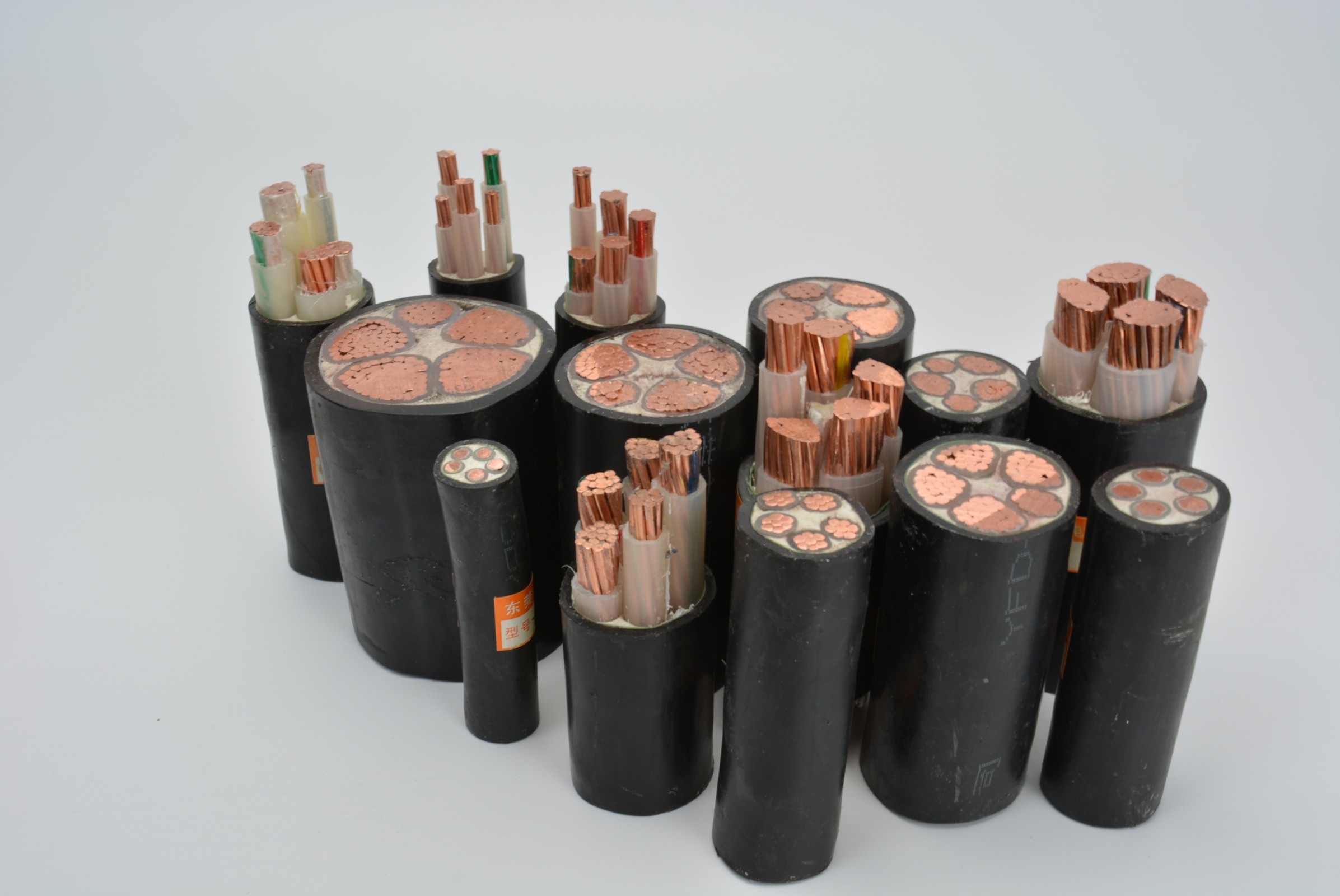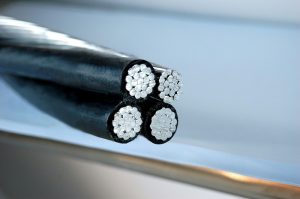

Hochspannungskabel sind in Frei- und Erdverlegung erhältlich.
Die ZMS-Kabelredaktion hat die Kabelklassifizierung und Namensdarstellung umfassend organisiert, aber auch eine detaillierte Einführung in die Kabelklassifizierung, damit Sie den Kabelkauf besser verstehen.
Der Schwerpunkt dieses Artikels liegt auf den folgenden drei Modulen.
1 Eine allgemeine Einführung in die Namensregeln und Klassifizierung von Kabeln.
2 Methoden zur Benennung von Kommunikationskabeln und kombiniert mit spezifischen Beispielen.
3 Im Design häufig verwendete Kommunikationskabel und Stromkabel.
Die Unterscheidung zwischen Drähten und Kabeln kennt keine strengen Grenzen.
Normalerweise, Produkte mit wenigen Kernen, kleine Produktdurchmesser, und einfache Strukturen werden Drähte genannt, solche ohne Isolierung werden blanke Drähte genannt, und andere werden Kabel genannt.
Leiterquerschnittsfläche größer als 6 Quadratmillimeter) bekannt als große Drähte, kleiner oder gleich 6 Quadratmillimeter, sogenannte kleine Drähte, Isolierter Draht wird auch als Stoffdraht bezeichnet.


Kabelprodukte werden hauptsächlich in die folgenden Kategorien unterteilt:
Das Hauptmerkmal dieses Produkts ist reines Leitermetall, ohne Isolierung und Mantelschicht, wie zum Beispiel Aluminiumlitze mit Stahlkern, Konvergenz von Kupfer und Aluminium, Elektrischer Lokomotivdraht, etc.
Die Verarbeitungstechnologie ist hauptsächlich Druckverarbeitung, wie zum Beispiel Schmelzen, Kalender, Zeichnung, Verseilung, dichte Druckverseilung, etc. Die Produkte werden hauptsächlich im Vorortbereich eingesetzt, ländlich, Hauptlinien des Kunden, Schaltanlage, etc.
Das Hauptmerkmal dieses Produkts ist die Extrusion (Wicklung) Isolationsschicht außerhalb des Leiters, wie z. B. isolierte Freileitungskabel, oder mehrere Adern verseilt (entsprechend der Phase, null, und Erdungsleitungen des Stromnetzes).
Zum Beispiel mehr als zwei Adern eines isolierten Freileitungskabels, oder fügen Sie dann eine Mantelschicht hinzu, wie Kunststoff- oder Gummikabel. Die wichtigsten Verfahrenstechnologien sind das Zeichnen, Strandung, Isolierextrusion (Verpackung), Kabelbildung, Panzerung, Ummantelungsextrusion, etc. Die verschiedenen Prozesskombinationen verschiedener Produkte sind etwas unterschiedlich.
Die Produkte werden hauptsächlich zur Übertragung starker elektrischer Energie in der Stromerzeugung eingesetzt, Verteilung, Übertragung, Transformation, und Stromversorgungsleitungen, durch den Strom (Zehn Ampere bis Tausende Ampere), Hochspannung (220V bis 500kV und darüber).
Die Hauptmerkmale dieser Kategorie sind: eine große Auswahl an Spezifikationen, ein breites Anwendungsspektrum, die Verwendung von Spannungen von 1 kV und darunter, Angesichts besonderer Anlässe werden weiterhin neue Produkte entwickelt.
Zum Beispiel feuerbeständige Kabel, flammhemmende Kabel, raucharme, halogenfreie Kabel, termitensicher, Rattensichere Kabel, ölbeständig oder kältebeständig, temperaturbeständig, verschleißfeste Kabel, medizinisch, landwirtschaftlich, Bergbaukabel, dünnwandige Drähte, etc.
Mit der rasanten Entwicklung der Kommunikationsbranche in den letzten zwei Jahrzehnten, Auch die Produkte haben eine erstaunliche Entwicklungsgeschwindigkeit hinter sich.
In der Vergangenheit entwickelten sich aus einfachen Telefon- und Telegrafenkabeln Tausende von Wortpaaren, Koaxialkabel, Glasfaser-Kabel, Datenkabel, und sogar kombinierte Kommunikationskabel.
Die Größe dieser Produktstruktur ist normalerweise klein und gleichmäßig, mit hohen Anforderungen an die Fertigungsgenauigkeit.
Wird hauptsächlich für verschiedene Motoren verwendet, Instrumente, Meter, etc.
Für den Kauf aller oben genannten sechs Kabelkategorien können Sie sich an ZMS-Kabellieferanten wenden.
Die vollständige Benennung von Kabeln ist meist kompliziert, Daher verwenden die Leute manchmal einen einfachen Namen, normalerweise der Name einer Kategorie kombiniert mit der Typspezifikation, um den vollständigen Namen zu ersetzen.
Zum Beispiel, “low-voltage cable” stands for all plastic insulated power cables of 0.6/1kV class.
Der Name des Kabelprodukts umfasst hauptsächlich die folgenden Elemente:
(1) Produktanwendung oder Name der Größenklasse
(2) Material oder Typ der Produktstruktur
(3) Wichtige Merkmale oder zusätzliche Merkmale des Produkts
Benannt in der oben genannten Reihenfolge, manchmal, um wichtige oder zusätzliche Merkmale hervorzuheben, die Merkmale werden vor bzw. vor der entsprechenden Strukturbeschreibung geschrieben.
Das Gesamtprinzip der Produktstrukturbeschreibung folgt dem Prinzip von innen nach außen: Leiter → Isolierung → Innenmantel → Außenmantel → Panzerungstyp.
Die Typenzusammensetzung und Reihenfolge der Stromkabel ist wie folgt:
Category – conductor – insulation – inner sheath – structural characteristics – outer sheath or derivative – make manganese wine container
Welche 1-5 Artikel und Artikel 7 mit dem phonetischen Alphabet, Polymermaterialien mit dem ersten Buchstaben des englischen Namens, Jedes Element kann aus 1–2 Buchstaben bestehen; Artikel 6 ist 1–3 Zahlen.
ZR (schwer entflammbar), NH (Feuerresistent), DDZ (geringer Rauch- und Halogengehalt), WDZ (niedriger Rauch und Halogenfrei), K (Steuerkabelkategorie), DJ (elektronischer Computer), N (landwirtschaftliche direkte Beerdigung), JK (Overhead -Kabelkategorie), B (Stoffdraht), Th (Für heiße und feuchte Bereiche), FY- (termitensicher, Unternehmensstandards), etc.
T (Kupferleiter), L (Aluminiumleiter), G (Stahlkern), R (Kupfer flexibler Draht).
v (Polyvinylchlorid), YJ (Vernetztes Polyethylen), Y (Polyethylen), X (Natürliche Butadien -Gummi -Mischungisolierung), G (Silikongummi -Mischungisolierung), Yy (Ethylen-Vinylacetat-Gummi-Gemisch-Isolierung).
v (Polyvinylchloridscheide), Y (Polyethylenscheide), F (Neopren -Mischungsscheide).
P (Kupfer -Netzschild), P1 (Kupferdrahtwicklung), P2 (Kupferbandschild), und p3 (Aluminium-plastische Verbundbandschutzschild).
Mit der Einführung der obigen Symbole, Ist es klar, die verschiedenen Kabelprodukte wieder zu sehen.
Kupfer ist das Hauptleitermaterial, das in Kabelprodukten verwendet wird, Der Kupfer -Kerncode t wird also weggelassen, mit Ausnahme von Produkten mit blankem Draht und blanken Leitern.
Produkte mit blankem Draht und blanken Leitern, Stromkabel, und elektromagnetische Drahtprodukte weisen nicht auf den Hauptklassencode hin, Elektrische Geräte und Kommunikationskabel sind nicht aufgeführt, sondern der kleine Klassen- oder Seriencode.
Artikel 7 ist eine Vielzahl besonderer Anlässe oder zusätzlicher besonderer Nutzungsanforderungen der Marke, in the “-” after the phonetic alphabet mark.
Manchmal, um das Element hervorzuheben, Der Artikel wird in den Vordergrund geschrieben.
Wie ZR- (schwer entflammbar), NH- (Feuerresistent), und WDZ- (raucharm, halogenfrei, Unternehmensstandards).
Der Metallleiter mit der besseren Leitfähigkeit ist Silber, gefolgt von Kupfer und Aluminium.
Aufgrund des hohen Silberpreises, zusätzlich zur Verwendung von Silber zu besonderen Anlässen und besonderen Zwecken, Eine Vielzahl von Kabeln sind häufig verwendete Leiter Kupferkerndraht oder Aluminiumkerndraht.
Kupfer ist ein guter Stromleiter, mit leitfähigen Eigenschaften, die nur Silber übertreffen.
Die mechanische Festigkeit von Kupfer ist hoch und lässt sich leicht kalandrieren. Zeichnen und Schweißen, und andere Verarbeitung. Mit guten physikalischen und mechanischen Eigenschaften und ausgezeichneter Prozessleistung.
Aufgrund der Situation, dass die Kupfer- und Aluminiumressourcen tendenziell abnehmen, Bei Kupfer geht es um die baldige Erschöpfung der Bodenschätze auf der Erde.
Aus der Perspektive der wissenschaftlichen Entwicklung, Aluminium statt Kupfer ist der unvermeidliche Entwicklungstrend.
In Bezug auf Kabelleiter, aufgrund der geringeren Festigkeit von Aluminium, Es ist schwieriger, einen schmalen Grat zu ziehen. Die derzeitige Verarbeitung von weichen Leitern und ultraweichen Leitern ist nicht realistisch.
Aber die Querschnittsfläche von mehr als 4 mm2 Kabel kann völlig gewährleistet werden, dass die Verwendung von Aluminiumleitern, die Kraft, Aluminium anstelle von Kupfer zu fördern.
Beides, um die Übertragungsfunktion sicherzustellen, sondern auch um die Inputkosten zu senken, im Einklang mit der Strategie der nachhaltigen Entwicklung.
(1) Es muss eine zuverlässige Verbindung im langfristigen Betrieb des Stromkreises gewährleistet werden. Wie wichtige Stromversorgung, und wichtige Betriebsstromkreise. Und Sekundärkreisläufe, die Erregung des Motors, mobile Gerätelinien, und die Linien schwerer Vibrationsanlässe.
(2) Explosionsgefahr oder Brandgefahr in Stromkreisen.
(3) Starke Korrosion von Aluminium und leichte Korrosion von Kupfer.
(4) Besonders wichtige öffentliche Gebäude, Kommandozentralen des Militärs, und wichtige Bürogebäude der Partei und Regierung. Und U-Bahn-Stationen.
(5) Der Platz neben Hochtemperaturgeräten.
(6) Mit Notfallsystemen und feuerlöschanlagenbezogenen Anlässen.
(7) Feuerbeständige Kabel.
(8) Der Arbeitsstrom ist größer, Sie müssen die Anzahl der Kabelkanäle erhöhen.
Zusätzlich, in Hochhäusern, große und mittelgroße Computerraumgebäude. Und wichtige öffentliche Gebäude. Zur Anpassung an ausländische Anforderungen inländischer und aus dem Ausland finanzierter Projekte und anderer Projekte sollte Kupferkernleitern Vorrang eingeräumt werden.
Das Obige ist eine umfassende Einführung in einige der Kabel. Wenn Sie Fragen zum Kauf von Kabeln oder Kabel-Basics haben, Gerne können Sie uns konsultieren, Wir verfügen über die professionellsten Kabelverkäufer, die Ihre Fragen beantworten.
Wenn Menschen den Begriff mineralisch isoliertes Kabel hören, many immediately think of harsh environments like…
Wenn Telekommunikationsnetzwerke und Stromübertragungssysteme schnell wachsen, the demand for reliable and cost-effective…
In groß angelegten Öl- und Gasprojekten, Industriekabel sind nicht nur Zubehör—they are the "nervous…
In der Welt der elektrischen Verbindungen, Kabelschuhe—auch als Kabelohren oder Kabelklemmen bezeichnet—Sind…
Bei der Auswahl des richtigen Kautschukkabels für ein Elektrotechnikprojekt, it is critical to…
Liebe Partner und Kunden: 29. Januar, 2025 ist das chinesische Neujahr – Spring…